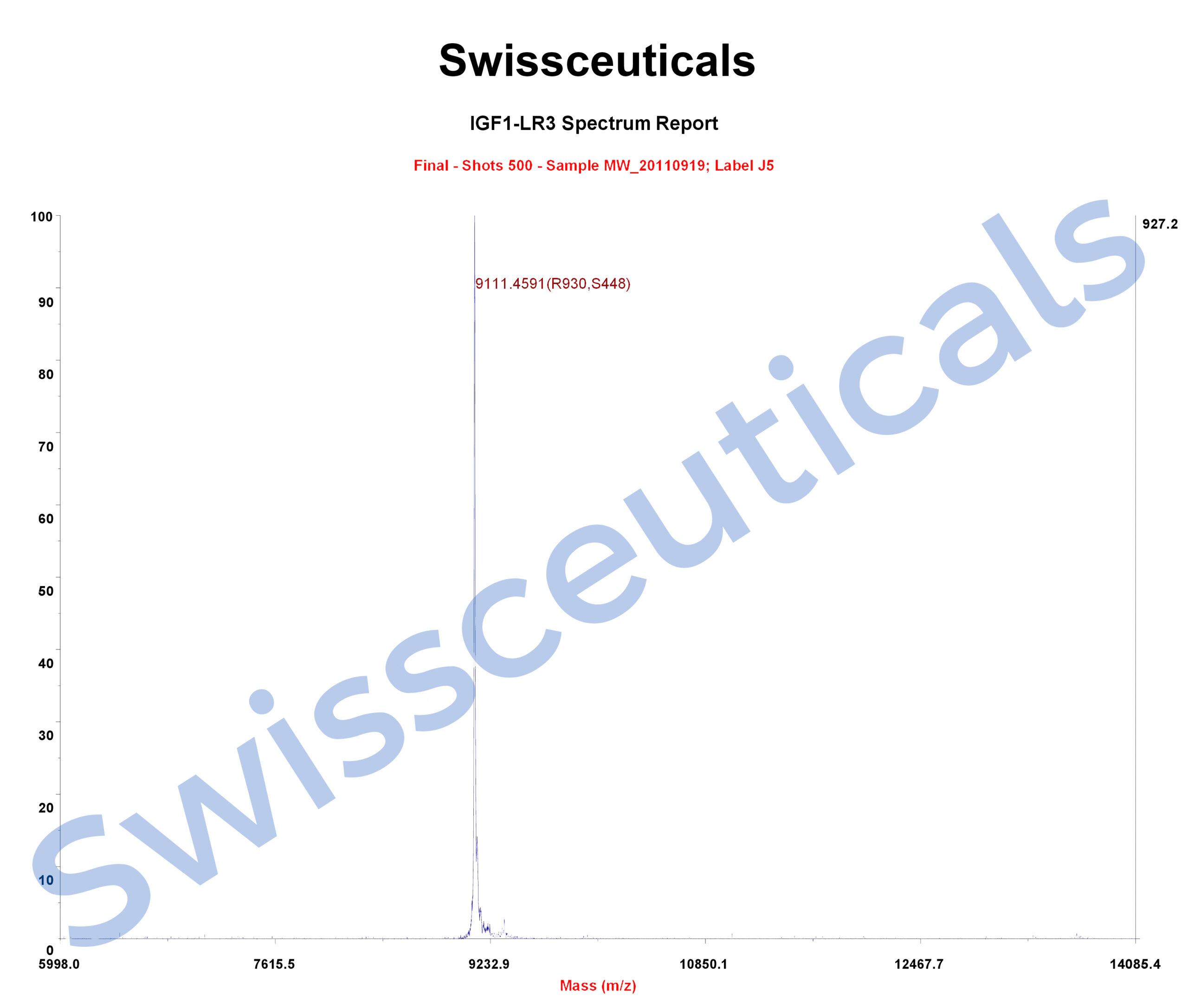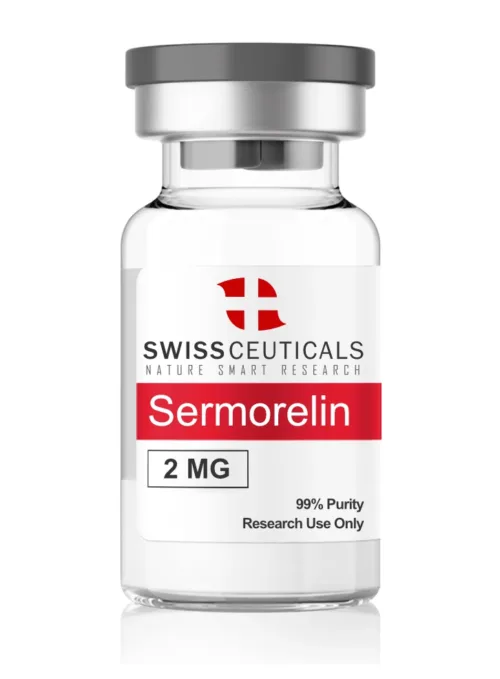IGF-1 LR3
$99.00
Free Bacteriostatic Water 30ml
with all orders!Free Bacteriostatic Water 30ml
with all orders!
Free Shipping to continental US
for orders over $200Free Shipping to continental US
for orders over $200IGF-1 LR3 (insulin-like growth factor-1 long arginine 3) is a synthetic, modified construct of insulin-like growth factor-1. Because IGF-1 LR3 does not bind to IGF-1 binding proteins very well, it remains active up to 120 times longer than standard IGF-1. This results in improved half-life for the peptide and thus increased activity. IGF-1 LR3 enhances cell division and growth, boosts fat metabolism, and increases muscle repair and hypertrophy by inhibiting myostatin. Recent research suggests that IGF-1 LR3 may also be useful in improving lactation among mothers with young offspring.
| Weight | 2 g |
|---|---|
| Dimensions | 5 × 10 × 12 cm |
What is IGF-1 LR3?
IGF-1 LR3 is a modified version of insulin-like growth factor-1. The full name of the peptide is insulin-like growth factor-1 long arginine 3. All IGF-1 derivatives play prominent roles in cell division, cell proliferation, and cell-to-cell communication. Though it has similar effects, IGF-1 LR3 does not adhere to IGF binding proteins as strongly as IGF-1. This results in IGF-1 LR3 remaining in the bloodstream 120 times longer than IGF-1. IGF-1 LR3 gains its prolonged half-life as a result of its structural changes. The peptide is created by adding 13 amino acids to the N-terminal end of IGF-1 and by converting the glutamic acid at position 3 of IGF-1 to an arginine residue.
IGF-1 LR3 Structure
Sequence: MFPAMPLSSL FVNGPRTLCG AELVDALQFV CGDRGFYFNK PTGYGSSSRR APQTGIVDEC CFRSCDLRRL EMYCAPLKPA KSA
Molecular Formula: C400H625N111O115S9
Molecular Weight: 9117.5 g/mol
CAS Number: 946870-92-4

Source: PubChem
IGF-1 LR3 Research
Cell Division
Like IGF-1, IGF-1 LR3 is a potent stimulus for cell division and proliferation. Its primary effects are on connective tissues like muscle and bone, but it also promotes cell division in liver, kidney, nerve, skin, lung, and blood tissues. IGF-1 is best thought of as a maturation hormone because it not only promotes cell proliferation, but differentiation as well. IGF-1 causes cells to mature, in other words, so that they can carry out their specialized functions.
Unlike IGF-1, IGF-1 LR3 remains in the bloodstream for long periods of time. This property makes IGF-1 LR3 a much more potent molecule. A dose of IGF-1 LR3 provides approximately three times as much cell activation as a similar dose of IGF-1. Note that IGF-1 LR3 and all IGF-1 derivatives do not promote cell enlargement (hypertrophy), but rather promote cell division and proliferation (hyperplasia). In the case of muscle, for instance, IGF-1 LR3 does not cause muscle cells to get larger, but it does increase total numbers of muscle cells.
Fat Metabolism and Diabetes
IGF-1 LR3 boosts fat metabolism in an indirect manner by binding to both the IGF-1R receptor and the insulin receptor. These actions increase glucose uptake from the blood by muscle, nerve, and liver cells. This results in an overall decrease in blood sugar levels, which then triggers adipose tissue as well as the liver to begin breaking down glycogen and triglycerides. Overall, this produces a net decrease in adipose tissue and a net energy consumption (i.e. net catabolism).
Given its role in reducing blood sugar levels, it should come as no surprise that IGF-1 LR3 reduces insulin levels as well as the need for exogenous insulin in diabetes. In most cases, this translates into a 10% decrease in insulin requirements to maintain the same blood sugar levels. This fact may help scientists understand how to decrease insulin doses in individuals who have decreased insulin sensitivity and may even offer insight into preventing type 2 diabetes in the first place.
Impairs Myostatin
Myostatin (a.k.a. growth differentiation factor 8) is a muscle protein that primarily inhibits the growth and differentiation of muscle cells. While this function is important to prevent unregulated hypertrophy and ensure proper healing following injury, there are times when inhibiting myostatin could be of benefit. The ability to stop myostatin from functioning could be useful in conditions like Duchenne muscle dystrophy (DMD) or in people who suffer muscle loss during prolonged immobility. In these cases, inhibiting this natural enzyme could help to slow muscle breakdown, maintain strength, and stave off morbidity.
In mouse models of DMD, it has been found that IGF-1 LR3 and other IGF-1 derivatives are capable of counteracting the negative effects of myostatin to protect muscle cells and prevent apoptosis. IGF-1 LR3, thanks to its long half-life, is highly effective in counteracting myostatin and appears to work by activating a muscle protein called MyoD[1], [2]. MyoD is the protein normally activated by exercise (e.g. weight lifting) or tissue damage and is responsible for muscle hypertrophy.
IGF-1 LR3 Longevity Research
IGF-1 LR3 promotes tissue repair and maintenance throughout the body, making it a protective molecule against cell damage and the effects of aging. Research in cows and pigs indicates that IGF-1 LR3 administration may be an effective solution for offsetting the effects of cellular aging. Ongoing research in mice seeks to determine if IGF-1 LR3 might be useful in preventing progression of a wide range of conditions such as dementia, muscle atrophy, and kidney disease. This research reveals that IGF-1 administration can prolong life and reduce disability[3], [4], [5, p. 1].

Lifespan of male and female mice is correlated with IGF-1 levels.
Source: ResearchGate
Glucocorticoid Signaling
Glucocorticoids, secreted primarily by the adrenal glands, are important clinical drugs used to control pain and reduce inflammation in autoimmune diseases, neurological injury, cancer, and more. Unfortunately, glucocorticoids have a number of undesirable side effects such as muscle wasting, fat gain, and deterioration of bone density. There is some interest in using IGF1-LR3 to reduce the side effects of glucocorticoids and thus allow for more effective therapy[6].
IGF-1 LR3 exhibits minimal to moderate side effects, low oral and excellent subcutaneous bioavailability in mice. Per kg dosage in mice does not scale to humans. IGF-1 LR3 for sale at Peptide Sciences is limited to educational and scientific research only, not for human consumption. Only buy IGF-1 LR3 if you are a licensed researcher.
Article Author
The above literature was researched, edited and organized by Dr. E. Logan, M.D. Dr. E. Logan holds a doctorate degree from Case Western Reserve University School of Medicine and a B.S. in molecular biology.
Scientific Journal Author
Dr. Anastasios Philippou, Ph.D. focused on Experimental Physiology at the National & Kapodistrian University of Athens Medical School. He is now a National Center Manager and Assistant Professor, however his extensive studying and documented research pertaining to the effects of muscle regeneration, the role of IGF-1 in skeletal muscle physiology, the expression of IGF-1 isoforms after exercise induced muscle damage in humans, characterization of the MGF E peptide actions in vitro, and epigenetic regulation on gene expression induced by physical exercise are most impressive.
Dr. Anastasios Philippou, Ph.D. is being referenced as one of the leading scientists involved in the research and development of IGF-1 LR3. In no way is this doctor/scientist endorsing or advocating the purchase, sale, or use of this product for any reason. There is no affiliation or relationship, implied or otherwise, between Peptide Sciences and this doctor. The purpose of citing the doctor is to acknowledge, recognize, and credit the exhaustive research and development efforts conducted by the scientists studying this peptide. Dr. Anastasios Philippou, Ph.D. is listed in [7] and [8] under the referenced citations.
Referenced Citations
- “Adipose Tissue-Derived Stem Cell Secreted IGF-1 Protects Myoblasts from the Negative Effect of Myostatin.” [Online]. Available: https://www.hindawi.com/journals/bmri/2014/129048/. [Accessed: 16-May-2019].
- N. Li, Q. Yang, R. G. Walker, T. B. Thompson, M. Du, and B. D. Rodgers, “Myostatin Attenuation In Vivo Reduces Adiposity, but Activates Adipogenesis,” Endocrinology, vol. 157, no. 1, pp. 282–291, Jan. 2016.
- E. Corpas, S. M. Harman, and M. R. Blackman, “Human growth hormone and human aging,” Endocr. Rev., vol. 14, no. 1, pp. 20–39, Feb. 1993.
- W. E. Sonntag, A. Csiszar, R. deCabo, L. Ferrucci, and Z. Ungvari, “Diverse roles of growth hormone and insulin-like growth factor-1 in mammalian aging: progress and controversies,” J. Gerontol. A. Biol. Sci. Med. Sci., vol. 67, no. 6, pp. 587–598, Jun. 2012.
- “IGF-I/IGFBP system: metabolism outline and physical exercise. – PubMed – NCBI.” [Online]. Available: https://www.ncbi.nlm.nih.gov/pubmed/22714057. [Accessed: 16-May-2019].
- B. Y. Hanaoka, C. A. Peterson, C. Horbinski, and L. J. Crofford, “Implications of glucocorticoid therapy in idiopathic inflammatory myopathies,” Nat. Rev. Rheumatol., vol. 8, no. 8, pp. 448–457, Aug. 2012.
- A Philippou, A Halapas, M Maridaki, M Koutsilieris – J Musculoskelet Neuronal Interact, 2007 [Semantic Scholar]
- A Philippou, E Papageorgiou, G Bogdanis, A Halapas… – In vivo, 2009 [Iiar Journals]
ALL ARTICLES AND PRODUCT INFORMATION PROVIDED ON THIS WEBSITE ARE FOR INFORMATONAL AND EDUCATIONAL PURPOSES ONLY.
The products offered on this website are furnished for in-vitro studies only. In-vitro studies (Latin: in glass) are performed outside of the body. These products are not medicines or drugs and have not been approved by the FDA to prevent, treat or cure any medical condition, ailment or disease. Bodily introduction of any kind into humans or animals is strictly forbidden by law.
Certificate of Analysis (COA)

High Performance Liquid Chromatography (HPLC)

Mass Spectrometry (MS)







